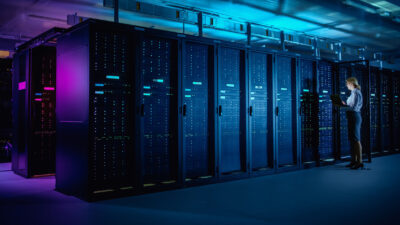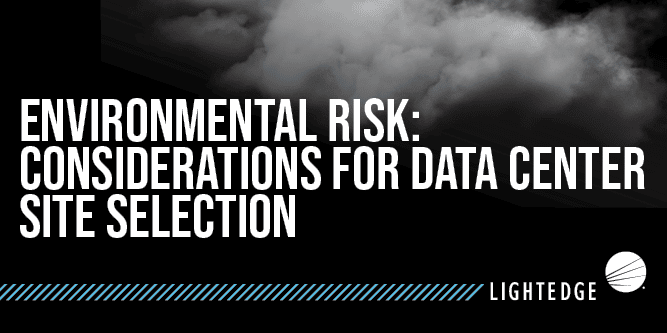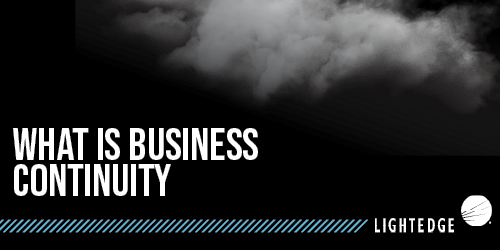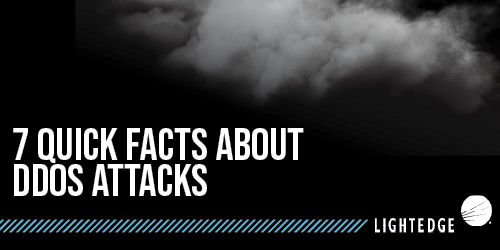5 Ways A Redundant Network Benefits Your Business
November 5, 2020

Lightedge
Author

If you’ve been shopping around for a new network or data center provider, you’ve probably heard the word “redundant” quite a bit. While this can feel like an overwhelming process, a redundant network is one of the best investments you can make for your organization and one that should be seriously vetted.
A redundant network creates a fast, reliable experience for your operations, your team members, and your customers. Low latency and always-on dependability give you the tools and the confidence to try innovative things with your applications, website, and end-user digital experience. Think of your network as the backbone to our IT environment. A strong network can set you up for delivering a truly differentiated client experience that your competition can’t match.
There is risk when you’re not redundant, as providers without carrier diversity have higher rates of single-point failure. Historically, many service providers that used to be real estate focused and don’t have network staff have begun leaning on partners to build their connectivity story instead of doing it themselves. This can increase rates of failure, leaving you and your employees or customers without access to your essential infrastructure.
Redundancy is all about business continuity. It involves putting fallback plans in place to ensure that your data, power, and hardware are covered in the event of an emergency and that your business stays operational no matter what. There are so many other elements of your tech solutions that can be affected by your network decisions. By learning about the types of redundancy, how they can benefit your business, and what to look for in a network and colocation provider, you can make the best decision for your organization.
Four Key Types of Redundancy
Network Redundancy is a large hopper that many different areas of your operations can feed into. It’s all about creating failsafe continuity plans across your critical infrastructure. Here are the most common areas of redundancy you should be focusing on when looking at your network, cloud or colocation provider.
Remember: your network is not just some abstract mass above your head in the cloud. It’s a readily accessible system of connectivity that requires physical equipment and well-planned fiber paths. It’s logistically very complex, so a provider that truly eats, sleeps, and breathes network is the level of sophistication you should demand and can be quite rare to find.
Pathway Redundancy
As information is sent from one location to another or as employees and customers try to access information remotely, pathway redundancy is crucial to maintain network speeds and integrity. If your Wi-Fi connection fails or a hardware issue arises, you don’t want to lose complete functionality. There should always be alternate routes you can take real-time.
Think of pathway redundancy like a city map. If there is road construction that blocks access to a common thoroughfare, a well-planned city will have alternate routes mapped out so everyone can quickly adapt and get where they need to go. A strong network provider will be able to have multiple pathways in and out of cities and across different carriers to failover to without end users even knowing the internet went down.
Power Redundancy
What would happen to your systems if your power were to go out? Are you covered, or would a freak blackout or nasty thunderstorm take out the majority of your infrastructure until you can get the lights back on? Power redundancy is exactly what it sounds like: having a backup power source so you have the ability to continue with business as usual in the event of a power grid disruption.
Power redundancy can look like a backup generator, battery backup, an alternate power supply unit, or even a presence on multiple power grids. Investing in power redundancy acts as an insurance policy so you don’t lose immeasurable time, money and customer trust down the road.
Geographic Redundancy
A few months ago, Iowa experienced a historic derecho. This wiped out power and destroyed hundreds of miles of land. We hope this never happens to you – and that your data centers are built to withstand such a catastrophic event— but if it does, we hope you also had the foresight to choose a provider who prioritizes geographic redundancy.
The key to geographic redundancy is for a provider to have data centers that are spread out far enough to avoid similar natural disasters. A solid provider should be able to route traffic out of other regions without any interruption to your service. For example, if a provider operates in an area that experiences wildfires, it would be good practice for them to have at least one other data center out of areas known to be impacted, and a strong provider would have a facility several states away to route through. A trend we’ve been witnessing on the consumer side is many corporations headquartered on either coast seeking a data center in the Midwest as an added layer of redundancy should they be hit with a disaster.
Data Redundancy
Data redundancy is most commonly cited in tandem with the other forms of redundancy above. If a fire takes out an office or data center, employees will still need to work and customers will still need to access portals or complete transactions. It’s not enough to simply have another facility. You need to be able to get all of your mission critical data at the secondary facility. You’ll find that many of these elements will often go hand-in-hand.
Key Benefits of a Redundant Network
Sometimes planning for redundancy can feel like a lot of work for what feel like abstract contingencies. It can often mean the difference between thousands of dollars, as well as, customer trust. If you’re not completely sold on the idea of redundancy, just check out five of the benefits you will reap once you start layering redundancy into your network strategy. These are the most common benefits—this list is by no means exhaustive. You may also find benefits that are unique to your business or industry.
1. Uptime
This is definitely the most obvious benefit of opting for redundant networks. Your network is always up and always on. This is especially important for organizations who need to provide 24-hour services to customers, patients or clients. If a hospital is experiencing outages, this spells disaster for staff and patients. If a bank has ATMs that cannot be accessed at any time of day or night, they will likely lose customers who favor the versatility of institutions who offer 24-hour access. Or if a manufacturer’s operations get impacted, it can result in millions of dollars in lost revenue.
If you don’t think downtime is a big deal, think again. According to Gartner, the average company loses $5600 per minute of network downtime, adding up to a whopping $300,000 per hour. That’s enough to prioritize a redundant network, as the benefits will far outweigh the cost if you do not.
Additionally, with many individuals working from home for the last several months, many of us have seen firsthand how frustrating and difficult it can be for a remote workforce to continue on when the network goes down—or to sync back up once the network is up and running again. Your redundant provider will give you the tools you need to prevent this from happening over 99% of the time.
2. Security
Cybersecurity relies on redundancy for maximum effectiveness. Redundant networks give your organization the opportunity to have state-of-the art security measures in place and the backing of successful compliance audits. With redundant networks, downtime doesn’t leave your information vulnerable as team members work to isolate and resolve the security concern. If you have the ability to failover to another network, your business can keep moving along uninterrupted so your IT security staff can manage the vulnerability.
Redundant networks are a key predictor in how well a company will recover from a cyberattack. If there are more layers to failover to, you will not have as devastating an impact on several elements of your bottom line. For example: if an e-commerce company’s network was attacked, having a solid failover rate will help them head off problems associated with lost sales.
Another recent example is the ransomware attacks that have been targeting hospitals around the country. The attackers locked down the network, rendering it unusable and demanded exorbitant sums of money to restore access. These events have been linked to at least one patient death. In today’s world, this is a risk that healthcare providers cannot afford to take. By opting for redundant networks, you take the power away from ransomware attacks and give it back to your business by providing failover options to keep your operations running and, in some cases, your patients alive.
3. Latency
If you feel the need for speed, redundant networks are the way to go, since they stop you from being overloaded. This is especially relevant today. If you have more and more business happening online since everyone went remote, you may be experiencing slower speeds or even crashes due to high traffic volumes.
Having multiple paths to access the same locations means you will be less likely to struggle with slow speeds from high traffic volumes. Going back to our city map metaphor, redundancy builds in backroads so you can avoid main thoroughfares that are prone to traffic jams and reach your destination without delay or accidents.
4. Business continuity
At the end of the day, keeping your business up and running, no matter what comes your way is the main goal of selecting redundant networks. In the midst of any major disaster or minor inconvenience, you should be able to keep moving toward your quarterly benchmarks and annual goals. You and your employees need the ability to continue with business, whatever issues may arise.
When your network goes down, don’t waste valuable productive hours waiting for it to get back up and running. Once again, that successful failover rate will save you lost productivity by allowing you to treat that failure like a minor hiccup. Gone will be the days of sending your staff home due to a network outage. You’ll be able to do what you need to do so you can be prepared for whatever was originally scheduled for your day, be it a big sales meeting or a website refresh.
5. Resiliency
When you’re dealing with network at a remote site, it is often difficult to quickly increase speeds in a timely manner. If you’re trying to grow your business, this could be a significant issue, since it will be harder to scale up as your traffic increases, leading to bottlenecks and site crashes. By placing your workloads in a redundant facility, you have practically infinite access to network that can scale immediately.
Additionally, with the right provider, you will never be left alone to solve the issues you might face while scaling up or mitigating risk. Smaller organizations often lack specialized internal staff to troubleshoot increasingly complex networks and are reliant on an IT generalist who may not have the hours in the day to get to every issue. Few companies can afford a staff of 24×7 network engineers that have built and maintained a business class network, but your network provider will be able to do this for you, giving you another layer of armor when you are looking to grow or strengthen defenses.
Here’s What to Look For
Cloud networks are a substantial financial investment that can also make or break your business, so it’s important to be vigilant and ensure that your potential cloud providers can confidently and demonstratively provide support in the following areas
- They must be able to provide adequate protection to all of their pathways, so you are protected from cyberattacks or data breaches.
- What is the longest stretch of downtime they’ve had in the last year? Ideally, the answer is none whatsoever, but the lower number, the better. Just because they experienced downtime does not mean that your organization will be in the impacted area.
- How many data centers do they have? How far apart are they? Are they located in areas known for natural disasters or unstable power supplies?
- Do they have routes around their carrier hotels? If not, what happens to your network when one of their carrier hotels goes down?
- How do they cover each one of the key types of redundancy? Do they have backup energy sources and hardware? Ask them point-by-point to get a better picture of their plan to keep your network up and on at all times.
- What is their response time? If you have a network connectivity issue in the middle of the night or on a weekend, how quickly can it be resolved?
Cloud networks are most stable when they are redundant in all the areas we’ve talked about previously. Those key areas of redundancy make it possible for your applications remain constantly up during 99.9% of emergencies. You may not be able to predict every single problem before it arises, but building in redundancies wherever you can will help you meet the challenges as they come along with minimal impact on your customers, employees, and bottom line.
Lightedge’s Redundant Network Makes Us Different
When asked about our differentiators, the first answer is always, “our network”. We design all our facilities and services around connectivity first for unparalleled scale, redundancy, speed and uptime. At Lightedge, we promise two things when it comes to your network:
- Your applications will always be up.
- Your applications will always be fast and accessible for end users.
We incorporate redundancy into every facet of what we do. All of our data centers have private interconnectivity between one another for seamless disaster recovery and regionally redundant uptime. Our unparalleled uptime gives our customers peace of mind knowing that they won’t lose precious time and money to an outage. If you’d like to connect with us to discuss your options for redundant networks, contact us today to schedule a call.


